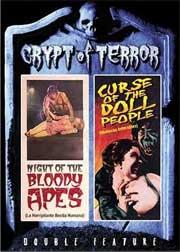 NIGHT
OF THE BLOODY APES (1969)/CURSE OF THE DOLL PEOPLE
(1961)
NIGHT
OF THE BLOODY APES (1969)/CURSE OF THE DOLL PEOPLE
(1961)Directors: Rene Cardona, Benito Alazraki
Deimos/BCI Eclipse
 NIGHT
OF THE BLOODY APES (1969)/CURSE OF THE DOLL PEOPLE
(1961)
NIGHT
OF THE BLOODY APES (1969)/CURSE OF THE DOLL PEOPLE
(1961)To inaugurate its new “Crypt
of Terror” DVD line, Deimos/BCI Eclipse has released a double feature
set of two very different Mexican horrors, each presented in two separate versions.
The films we’ve come to know as NIGHT OF THE BLOODY APES and CURSE OF
THE DOLLS PEOPLE have both been available on DVD before, but this “special
edition” brings enough alternate and extra attractions to the table to
warrant a double-dip purchase.
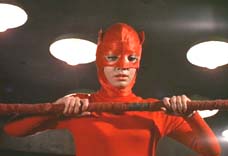
Most Mexican horror films
are tame allegories, aimed at the kiddies. NIGHT OF THE BLOODY APES is one of
four titles made by Rene Cardona in the late 1960s with an extra dose of sex
and gore to titillate the grown-ups in "international" Spanish-speaking
movie markets other than Mexico. Although the others (including the likes of
"The Vampire and the Sex" and "The Lepers and the Sex")
are impossible to locate in their complete incarnations, this film was wildly
distributed in its spicy variant (originally titled "Horror and Sex")
and believe me, the blood flows like the cheese running on your plate of hot
refried beans!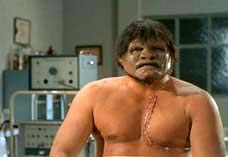
Again Cardona throws in wrestling (remmber DOCTOR OF DOOM?), this time a female garbed in a red devil catsuit. One night she flings an opponent out of the ring, causing serious injury. Proving that wrestling is fake, with great concern, she visits her impaired rival (now comatose) in the hospital with her detective boyfriend. In the meantime, Dr. Krauman is a brilliant surgeon whose son Julio is dying of Leukemia. The clever doc decides that he's going to give the young man a heart transplant to save his life.
Krauman and his crippled
assistant (who even addresses the doc as "master") sneak into the
local zoo and spot an orangutan. Through the miracle of special effects, the
orangutan soon becomes an actor in a cheap gorilla suit, and the doctor tranquilizes
and kidnaps the animal and brings him back to his lab. He then transfers the
heart of the gorilla into his son's body, courtesy of some genuine graphic heart
surgery footage that caused the film to find a home on Great Britain's notorious
"Video Nasty" list in the 1980s.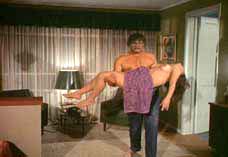
Of course, the experiment fails, and the angelic-looking Julio periodically transforms into an ugly ape-creature. Now played by a much beefier actor, Julio roams the Mexican streets with nothing on but his blue pajama bottoms and massive chest scar exposed, all while trying to keep the clay make-up on his face and the plastic teeth in his mouth. He stumbles upon a seductive senorita just getting out of the shower. He breaks in and carries her naked, fainted body to the bed. Frustrated since he can't figure out how to have sex with his pajama bottoms on, he rips the girl to shreds in a series of blood-soaked close-ups. The rest of the film has Dr. Krauman desperately trying to save his son, even kidnapping the comatose female wrestler to employ her heart. But all fails, and the beast just keep killing.
 Extra
gore and sex was inserted for the international “Horror and Sex”
version, as well as additional fluff added at a later time by American distributors.
For the most part, the insertions are sloppy, complete with abrupt, uneven music
cues. When a redhead is assaulted by the monster in a park, her blue dress is
torn to shreds, and a scene where she runs off -- showcasing an exposed breast
flopping about -- is shown twice. When the girl runs into a grocery for help,
the dress is magically reassembled (since it was never torn up in the "clothed"
version). And there are plenty of other scampering naked women about in the
picture!
Extra
gore and sex was inserted for the international “Horror and Sex”
version, as well as additional fluff added at a later time by American distributors.
For the most part, the insertions are sloppy, complete with abrupt, uneven music
cues. When a redhead is assaulted by the monster in a park, her blue dress is
torn to shreds, and a scene where she runs off -- showcasing an exposed breast
flopping about -- is shown twice. When the girl runs into a grocery for help,
the dress is magically reassembled (since it was never torn up in the "clothed"
version). And there are plenty of other scampering naked women about in the
picture!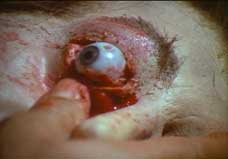
Other carnage includes an
eye (resembling a deviled egg) gauging, decapitation, and a scalping -- another
ingenious effect that has the ape slowing pulling off the toupee of a bald guy's
head to reveal a bloody pulp. Add terrible dubbing (a street cop is given a
heavy Irish accent), plus absurd dialog (a doubting police chief says to the
detective, "It's more probable that of late, more and more you're watching
on your television ... many of those pictures of terror") and you have
an irresistible, must-see piece of trash on your hands.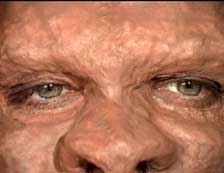
On the flip side of the disc
is the standard Mexican version, known as “La Horripilante Bestia Humana.”
This cut of the film is shun of all nudity and extreme violence, but also offers
alternate “clothed scenes,” some extended dialog scenes, and several
tamer death scenes, different from the ones extended (and exaggerated) with
new footage by the American distributors. This version is presented in the original
Spanish language, with optional English subtitles. 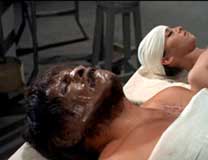
The transfer used here for NIGHT OF THE BLOODY APES is the same seen on the Something Weird/Image disc (where the film is paired with FEAST OF FLESH). The image is sharp, full of detail, and truly brings out the vivid 1960s colors of this exploitation gem. The film is presented full frame and there are some minor blemishes on the source print, but just the same, the image looks excellent. The mono sound is also fine for a dubbed film of this vintage. The Mexican version is darker and not nearly as well-detailed, but perfectly watchable, and it’s nice to finally get a glimpse of what originally played in South of the Border theaters.
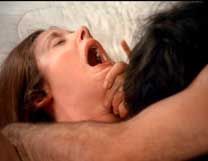 Extras
include three minutes of outtakes (which are also available on the Something
Weird/Image release) which centers on the newly added gore scenes, as well as
several brief shots from the original Mexican cut. The outtakes are all silent.
The outrageous American trailer is also included, as well as a still gallery
which includes various poster and pressbook art and video covers. The back of
the packaging claims that “TV spots” are supplements here, but they
aren’t present on the disc.
Extras
include three minutes of outtakes (which are also available on the Something
Weird/Image release) which centers on the newly added gore scenes, as well as
several brief shots from the original Mexican cut. The outtakes are all silent.
The outrageous American trailer is also included, as well as a still gallery
which includes various poster and pressbook art and video covers. The back of
the packaging claims that “TV spots” are supplements here, but they
aren’t present on the disc.
The second disc in this set contains the American and Mexican versions of CURSE OF THE DOLL PEOPLE (originally known as “Muñecos Infernales”). For obvious reasons, this K. Gordon Murray presentation of a Mexican-made film stands out in the minds of fans who caught it on television in the 1960s and 1970s. I saw it in the late 1970s on New York's Channel 9 on a Saturday afternoon double-billing with Bert I. Gordon's VILLAGE OF THE GIANTS (a clever pairing) and I never forgot it.
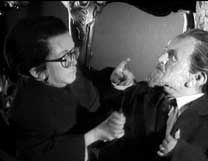 The
plot has a group of archeologists defiling a voodoo temple by stealing a sacred
idol. They are cursed by a voodoo priest who forewarns that they and their families
will die horrible deaths. Each of the men killed are turned into small, three
feet dolls (played by either "little people" or children in disturbing
masks) which are then animated as killer zombies. The dolls go around pricking
their victims with large needles, and the real eerie part about it is that they
assume the likeness of the men that they just killed!
The
plot has a group of archeologists defiling a voodoo temple by stealing a sacred
idol. They are cursed by a voodoo priest who forewarns that they and their families
will die horrible deaths. Each of the men killed are turned into small, three
feet dolls (played by either "little people" or children in disturbing
masks) which are then animated as killer zombies. The dolls go around pricking
their victims with large needles, and the real eerie part about it is that they
assume the likeness of the men that they just killed!
Aside from the bad dubbing on the American version -- including a half a dozen people screaming as if they were a theater audience, and a wolf from one of those "Sounds of Horror" Halloween records howling every time something scary happens --it's quite atmospheric and chilling. The masks on the tiny actors are stationary (they are supposed to be dolls), but are quite unsettling, and they actually pull their roles off convincingly. One of them even wears glasses, and he's the one that prevents the others from stabbing a little girl getting a glass of water in the middle of the night.
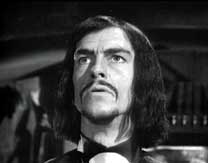 The
voodoo priest (Quintín Bulnes with long hair, mustache, and a snake drawn
on his robe) also has a full-sized zombie that resembles the title creature
in Edward L. Cahn's VOODOO WOMAN (1957). A truly odd scene has the rotting corpse
summon one of the little dolls like a pied piper, then walking off with him,
patting him on the head for doing a deed for his master! The climatic good vs.
evil confrontation, adorned with the high priest's impressive black magic paraphernalia,
is very reminiscent of the finale of HORROR HOTEL, made around the same time.
The
voodoo priest (Quintín Bulnes with long hair, mustache, and a snake drawn
on his robe) also has a full-sized zombie that resembles the title creature
in Edward L. Cahn's VOODOO WOMAN (1957). A truly odd scene has the rotting corpse
summon one of the little dolls like a pied piper, then walking off with him,
patting him on the head for doing a deed for his master! The climatic good vs.
evil confrontation, adorned with the high priest's impressive black magic paraphernalia,
is very reminiscent of the finale of HORROR HOTEL, made around the same time.
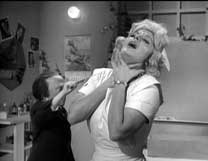
For this title, it’s best to go with the Mexican version, shown complete in the original Spanish language with optional English subtitles. The black and white image has good contrast, and looks fairly sharp with only minor softness and minimal print damage. The Spanish audio track also fairs well. Unfortunately, the flip side's presentation of the American International U.S. TV version (culled from a decent, but somewhat marked up 16mm print) only runs about 69 minutes, shy of over 10 minutes of important footage. Nothing from the Mexican original was ever excised from the Paul Nagle-directed American cut, so those who have the Beverly Wilshire DVD of this title (which is considerably inferior in quality to both versions presented here, but presents the film at its proper running time) will want to hold on to it in order to posses a complete English language version.
The only extra for CURSE is a still gallery, but inside the packaging is a booklet with excellent, informative liner notes about the films and their casts written by David Wilt. (George R. Reis)